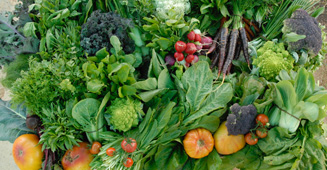

Contributor
- Topics: Archive

We arrived at the farm after midnight. The plane had come in low enough over Riyadh to display orderly rows of glittering lights and curving, palm-lined roads flowing with endless rivers of car headlights. Its darkness held complete mystery to us. An assistant to the Prince—dignified in a white robe and a scarlet and white checked gutra—met us, and our quickly planned trip to an unfamiliar place became reality.
We had come to Saudi Arabia for several weeks to consult for a Prince’s organic farm. At the farm, Saifel Islam, one of the workers from Bangladesh showed us our accommodations, a small trailer. He turned on some large outdoor lights and gave us an illuminated midnight tour of a field of cauliflower standing stiffly at attention below an overstory of date palms with the rounded contours of a limestone bluff behind. We shivered though our first night under insufficient covers as temperatures dipped to freezing.

Daylight revealed a landscape composed of the ancient and the new: small, flood-irrigated vegetable plots surrounded by the castle-like ruins of the historic mud-brick city of Diriyah, snaking drip irrigation lines, plastic greenhouses, Bermuda grass gone wild, and a cluster of four pre-fab metal houses. The colors were all taupes and tans, gray palm fronds and a pale blue sky, against which the Bulbuls—endlessly cheerful black, white, and bright yellow birds, appeared as animated cutouts against the muted backdrop. Dust was everywhere. We began an assessment of the farm, its methods, workers, resident junk, date palms, fruit crops, irrigation systems, weeds, and an array of vegetables.
We met the Prince through a mutual friend in London. There, we had meetings at Daylesford Estate Farm Shop and at Whole Foods in Kensington where, over fresh organic food produced in the lush greenness of the British Isles, far from the parched skies of the desert where we were headed, we learned of his holistic vision for an organic farm.

Riyadh is 1900 feet in elevation, considered arid desert and receives only 100 millimeters of rain a year—but not every year. Groundwater, which is of fossil origin captured between 18,000 to 22,000 years ago when the climate was wetter, has a very high salt content from lying so long on the bedrock. This, along with intense evaporation, has resulted in soils with between 2500 to 8000 ppm of salts. That salinity creates alkalinity and mineral imbalances that make growing conditions difficult for many plants. The farm is on the edge of the Wadi Hanifah, a valley in central Saudi Arabia where a large and intricate dry watershed complex acts as a floodway for the city of Riyadh. Driving through this region on the way to the Prince’s farm we passed high stone and adobe walls surrounding beautiful farms and estates owned by others in the royal family.
It was evident the farm needed a lot of work. The fruit trees—figs, pomegranates, and citrus—had all been hacked with some blunt instrument. The foliage of the citrus trees was pale and showed signs of iron chlorosis and the sandy soil appeared devoid of organic matter. Most of the vegetables looked healthy, though they were light green and clearly lacked nitrogen. Mallow, bindweed, and Bermuda grass festooned many of the beds and irrigation ditches. In the greenhouse, summer squash, oregano, and parsley had intense powdery mildew, and the tomatoes were spindly and pale.
Drip irrigation lines were haphazard and patched together. Most of the rectangular plots were flood irrigated, which involved turning on a pump to generate a flow of water down a long ditch. Small dirt dikes were breached one after the other and the plots were allowed to flood with a few inches of water. The dikes were then closed with a couple shovels full of soil. This irrigation practice involved a lot of standing around watching water, and took the workers about one-third of their day in spring and summer.

Our goals were to develop a systematic and efficient approach to the work and educate workers in best practices for organic growing methods, focusing on prevention rather than reaction. We also brought many unusual colored and flavored vegetables to trial to see what would express vibrant flavors and thrive with the site’s climate, pest, and disease pressures.

Our first task was a big cleanup. Dust, dirt, and sweat covered our faces as, working alongside the reluctant workers, we collected and removed two 20-yard dumpsters of trash and debris. Instead of burning plant refuse, we showed them how to make compost and vastly increased the amount of compost and organic fertilizer incorporated into the beds. The compost provoked the workers’ ire, as they believed dark matter in the soil was bad. We got drip irrigation parts and demonstrated how to fix and set up the lines properly and converted most of the previously flood irrigated plots to drip. We taught them how to prune trees. We determined which plants actually needed space in the greenhouses, and which did not or were too disease-prone to make growing worthwhile.
To encourage beneficial insects, I developed a blend of seeds readily available in the herb market: alfalfa, zattar, coriander, fennel, nigella, and wild arugula, adding in alyssum I had brought from home. I planted this mix in the watering basins around the palms and in odd beds around the farm. We encouraged the workers to leave native plants uncut to provide habitat for beneficial insects and showed them the difference between good insects and bad. We planted a large variety of colorful and flavorful vegetables as well as flowers. Then we went home. We were there three weeks.
We returned in March, six weeks later, to discover our “new ideas” had not been embraced. The flowers and beneficial insect plants had been weeded out but the weeds remained. The tomato seedlings in the greenhouses were not thinned or trellised. It was a jungle. The drip irrigation lines had many leaks that would have been simple to fix. The newly planted beds had no discernable compost and the workers rebelled at working more than six hours a day. It was evident that this project was going to be a challenge.
Every couple of days we were summoned to the Prince’s office for lavish lunches and we received several invitations to the Diplomatic Quarter, including lunch with the American ambassador, and an invitation to the Irish Ambassador’s St. Patrick’s Day party and musical events at the French embassy. We persevered. My husband Ben stayed on in Riyadh for three months to babysit all the plantings and drip systems.

Despite repeated admonishments from the workers that nothing would grow, over the next two years we converted most of the farm to drip irrigation so it took only ten minutes to water the entire farm by just opening a valve. This greatly minimized the amount of water used and lessened the amount of salts generated. Changing the shape of the beds from large rectangles to long straight rows made weeding, planting, and harvesting much easier. The benefits of adequate compost and fertilizer emerged over time with the production of gargantuan vegetables, the likes of which the workers had not seen before. In the end, all this and the many unusual, beautiful varieties engaged them: purple broccoli; Romanesco cauliflower; purple and red carrots; red, magenta, and orange chard; giant orange and multicolored tomatoes in the greenhouse like Gold Medal, Pineapple, Persimmon, and Pink Oxheart; scented basils, Easter egg radishes, Japanese vegetables, and many other varieties. When the flowers bloomed—sunflowers, alyssum, and orange cosmos—the fellows danced among them. In the greenhouses, the lesson that healthy soil creates healthy plants was strong. Increasing organic matter and soil fertility and providing adequate irrigation diminished root-knot nematodes and blight.
There were many pests and diseases each spring and summer season in Saudi Arabia. We learned to select vegetable varieties very carefully, concentrating on those adapted to hot climates and from regions that had similar humidity and pest issues to the Middle East. Varieties from India, Southeast Asia, and Egypt did well, while many European varieties failed in the summer. We learned about many new pests and what conditions favor them. Some plants like tomatoes and cucurbits had to be grown in the greenhouse or under secure row covers to protect the fruit from whiteflies, the melon fly, and extreme heat. Scarab beetles emerged in profusion if weeds were allowed to grow around the greenhouses. Darkling beetle larvae had a fetish for the drip lines and made tiny holes in them nightly. Wild dogs destroyed row covers. The list went on.

There were pleasant surprises as well, such as the many bird species on the farm, which included Black Eagles, Pharaoh Eagle-owls, and Hoopoes feasting on beetle larvae. We encountered giant swarms of migrating dragonflies, many insect-eating songbirds, and a host of beneficial insects that visited the alyssum and other insectary plants we planted. We saw many parasitic wasps and wild bees pollinating the flowers and crops.
We learned that it takes a lot of time to show that change is good. Naively, we assumed the workers would recognize the benefit of our new ideas. We came to realize that it takes time to let go of the familiar and not see newness as a threat. Ben deserves a minor state department position for his positive communication skills and for distilling the gist of our efforts into two key phrases designed to alleviate confrontation and build possibility: “new idea” and “team, team, team.” In the end, along with the farm, we benefitted immensely as well.









Responses